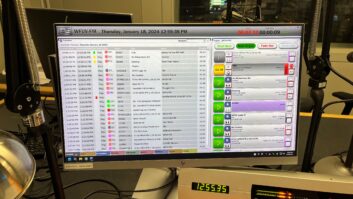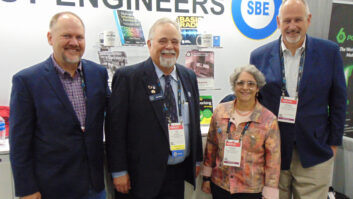
Omnia.11
MINNEAPOLIS — I’m a longtime fan of the Omnia product line, having recommended and run Omnia.fm and Omnia-6 processors over the years. So once I heard that Frank Foti and Corny Gould were teaming up on a new box, I had to get my hands on it.
It was the Omnia.11, and it was introduced at an NAB Show where I could play with it but, disappointingly, not take it home. Soon enough, however, I had one in hand here and was able to perform beta testing and A/B comparisons against a competitor’s flagship processor. The Omnia.11 was an impressive, clear winner; and we subsequently put it on the air at KTWN(FM).
Dual purposes
I’m a contract engineer who keeps an eye on 41 stations; and for five years I have been chief engineer for KTWN, or “96.3 K-TWIN.” The station is part of Northern Lights Broadcasting, owned by the Pohlad family; it serves Minneapolis from its city of license Edina.
The Omnia.11 is well suited to K-TWIN, which uses the slogan “Radio for Us: Community, Sports, Music.” As that phrase implies, the station airs a real mix of voice and musical content.
A recent half-hour gives you a taste of the musical selection: Blondie’s “The Tide Is High,” Phillip Phillips with “Home,” Moby with “South Side,” Peter Gabriel’s “Red Rain,” Emeli Sandé “Next To Me,” The Power Station’s “Get It On (Bang a Gong),” Aerosmith’s “Rag Doll” and Adele’s “Chasing Pavements.” For such content, in this market, our air processor must be musical, transparent, loud and clean.
But sports is an important part of the content mix too, and our newest addition is particularly exciting: The Pohlads own the Minnesota Twins, and just this year KTWN became the flagship home of the baseball club. We air those live games in mono. So for that content, our on-air box needs to be an effective, faithful voice processor.
Minneapolis is a competitive market for processing; there are powerhouse players here including Clear Channel, CBS, Hubbard and Cumulus, formerly Citadel; and some of these guys spend serious money on processing.
Traditional loudness wars might be on the way out, but any jock or PD still wants to be the loudest. I work with them to get the most out of their processor, to work toward sounding better rather than just loud and distorted. Omnia’s boxes were already loud; you couldn’t get much louder; the push in designing the 11 was to make it as loud and exciting as the older boxes but with even more clarity and control.
Omnia emphasizes certain characteristics: loudness, a “thunderous” bottom, sparkling highs and crisp voice reproduction. The AGCs, compressors and limiters, Omnia says, analyze music in real time and adjust parameters for the best performance across a broad range of material.
K-TWIN offers such a range of material, and I can attest to how well it does the job.

Omnia Remote Control
Among features that Omnia put in are a Density Detector that enables it to handle very compressed content; an “ultra-multiband limiter” system; a significant bass enhancement algorithm; and an Ultra LoIMD Distortion Controlled Clipper System to reduce IMD in the pre-emphasized final limiter/clipper. (You can read a useful explanation of that last one at http://omniaaudio.com/11.)
I love the parametric EQ control and great stereo space enhancement; I really like the way the box handles the high end. Where other processors produce a strident or lifeless sound, I can get a real nice, sparkly top end with the 11, and a rich sound throughout the rest of the spectrum.
I’ve got a couple of tricks up my sleeve to try make vocals pop, to control the most audible area of the sound yet still attack it. I’m very particular about my station sound; I started with a few of the factory presets, but I quickly tweaked up my own and locked them down.
Our new Operations Manager Michael Steele, who came from Los Angeles, has very high expectations for audio; and he said we have the best-sounding station in town, bar none.
Control in the field
The user interface on the 11 also is a vast improvement over other offerings. It uses the same sort of topology as past Omnia boxes but offers a lot more control.
Its big 10-1/2-inch touchscreen draws attention; but I particularly appreciate how easy remote access is via browser or Wi-Fi. We run the processor at the transmitter site and I have a private extension of the WAN out there. I really enjoy that I can get into the box from about anywhere so that I’m adjusting processing in the natural listening environment.
In fact, I can access my Omnia.11 by remote from my car. The programmers might say, “Hey I need a little more here, some drum kick there,” and I’ll take them out into the car so we can play with it. I also do it at home; I can actually sit there and adjust the processing in the real environment.
The single sideband suppressed carrier option on the stereo generator is pretty cool; 96.3 is a little “height challenged,” so we do have a bit of multipath. I was sitting in a parking lot downtown; I heard some multipath, so I dialed in from the car and turned the SSBSC option on, and bam, it was clear.
The Omnia.11 serves “twin” purposes in one other way: You can buy this box with or without HD Radio processing. The FMHD model offers separate processing paths for analog and digital; or you can get just the FM version, with the option to upgrade to HD later.
I met Frank Foti when I was working for a Clear Channel station, KDWB, here in town; this was before the first Omnia.fm was released, in the mid-1990s. He came in with one that didn’t even have front-panel control; you had to Telnet in via a PC.
It was really cool to be part of Omnia when the company launched. Its latest offering is no less impressive.
For information, contact Omnia at (216) 241.7225 or visitomniaaudio.com.
###












